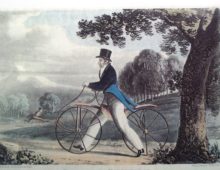Tagged with Steam power
Resource : Locomotion No. 1
This is the first steam powered railway engine to run on a public railway. It was designed by George Stephenson and sparked a transport revolution that transformed the lives and fortunes of people across Britain and the wider world.
Resource : The Fighting Temeraire
JMW Turner is one of Britain’s best loved artists. He became known as the ‘painter of light’ due to his trademark style and use of colour in landscapes and seascapes. The Fighting Temeraire, one of his most famous oil paintings, shows the warship Temeraire being towed by a steam-powered tug on its last ever journey before being broken up. It is said to symbolise the decline of Britain’s naval power, the passing of the ‘glorious’ age of sail and the growth of ‘modern’ technology in an increasingly industrialised Britain. The industrial revolution and the history of the Royal Navy were therefore both saluted, through Turner’s revolutionary brand of romantic landscape painting.
Resource : Boulton & Watt engine
James Watt’s ingenious improvements to the steam engine transformed this relatively simple technology, making it more efficient and adapting it so it could be used to turn wheels. His ideas revolutionised steam power, literally driving the industrial revolution and transforming the British landscape and the lives of its people.
Resource : Koenig and Bauer’s steam powered printing press
The industrial printing press was one of the most influential inventions of the Age of Revolution. It allowed thousands of copies of all types of written texts and images to be printed quickly and cheaply. Pamphlets, newspapers, handbills and books could now be mass produced and distributed, spreading news, ideas, political and social campaigns, propaganda, stories, poetry and more.
Resource : Launch of the Great Britain Steamship,1843. Lithograph of a painting by Joseph Walter
Isambard Kingdom Brunel’s SS Great Britain is one of Britain’s most important ships. By combining size, power and innovative technology, Brunel revolutionised sea travel and paved the way for modern ship design.
Resource : Luddite ticket
In the early 1700s, work in the textile industry was mainly hand-operated and undertaken by people skilled in crafts – such as weaving and knitting. But innovations in steam power and the design of machinery in the late 18th and early 19th century transformed manufacturing and the way people worked. Much of the new labour could be undertaken by unskilled workers in factories away from the household, quicker than ever before and for a fraction of the price. Skilled textile workers, who found their livelihoods threatened by new, labour-saving technology, responded witha series of violent protests. They became known as the Luddites.
Resource : Newcomen Beam Engine
The atmospheric engine was invented by Thomas Newcomen in 1712. It was the first machine to be powered by steam and was largely used to pump water out of mines. Hundreds of these engines were made and used all over Britain and Europe in the 1700s. They became known simply as the Newcomen Engine and helped pave the way for the Industrial revolution.
Resource : Train ticket: Liverpool to Warrington
The advent of steam hauled railways in the 1820s quickly revolutionised passenger travel and the transport of goods across Britain and the wider world. This is an early train ticket for a journey from Liverpool to Warrington.
Resource : Textile sample books
Cotton was one of the latest textile fibres to be introduced to Britain as a raw material within a manufacturing system, but between the eighteenth and nineteenth centuries it rose to prominence as a cornerstone of the British economy. Cotton manufacture stimulated industrialisation, global commercial influence, and new communities of labour. This is one of five early sample books illustrating the cotton and calico designs produced by the textile industry in Salford between 1769 and 1851.
Resource : Crompton’s spinning mule
The spinning mule was invented by Samuel Crompton in 1779. It revolutionised textile production by vastly increasing the amount of cotton that could be spun at any one time. But this also meant textile manufacturers no longer needed to pay individual spinners to create spindles (wooden rods) wound with cotton thread, as just one operator could now use the machine to spin hundreds of spindles at once.


